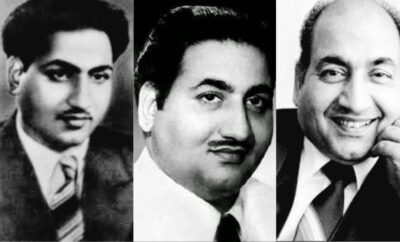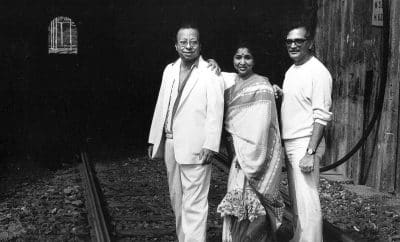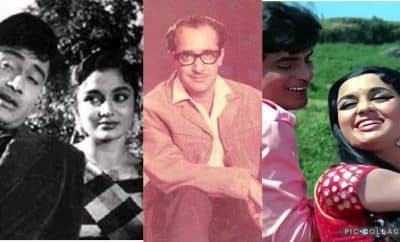Legends
The Story Of A Sindbad – Shankarrao Biniwale
Sindbad – The Sailor!!! How many of us have been listening to the fictional story of his 7 voyages? His adventures, encounter with monsters, magical spells, supernatural phenomenons. He hailed from Baghdad and enchanted us with his adventure stories. But all fictional, right? How about a real Sindbad? What if you get to know a real Sindbad in your life? Wouldn’t it be fascinating? Well, we do have a real Sindbad here. So says music director Kaushal Inamdar. To know more about that Sindbad, we need to know his story, his work, his real name. The story of a real life Sindbad is narrated to us by Kaushal Inamdar in Marathi here and I’ve translated that into English for the benefit of non – Marathi readers. Here it goes –
I had been to Manik Verma’s place some years back. I had composed music for Shanta Shelke’s poems for my album ‘Shubhra Kalya Moothbhar’ (Handful of White buds) and I keenly wished that Manik Verma should inaugurate the album. Manikbai heard the entire album with patience and gave her consent lovingly to come for the inauguration.
“Your tunes are very melodious” she said, “Do you come from a musical background?” she asked.
“My grandfather was a violinist” I replied, “He lived in Pune”.
“During our days, we had a violinist in Pune. He had a very deft hand. He used to play classical and light both very well. His name was Shankarrao Biniwale”.
My heart swelled with pride. It was a beautiful coincidence that Manikbai mentioned this name.
“I’m his grandson” I said.
My grandfather – Shankarrao Biniwale (we used to call him Appasaheb) – It has been 14 years since he passed away (The article was written in 2008) and coincidentally my first step in the music field as a composer was also 14 years ago. I miss him at every step in my musical journey. I still feel I would have been more enriched person as a musician if I had his concomitance for a longer period.
Appasaheb was a quiet person. He hardly spoke and talked even lesser about himself. And that’s the only reason that even today he’s been unfolding like a jigsaw puzzle in front of me. Even today one of his photographs or a newspaper cutting carrying his news tells something new about him and those facts have always been a revelation for me.
All my memories about him are connected with his residence which was situated at 2, Narayanpeth, Opp. Kesari Wada, Pune where I usually spent my summer holidays along with my brother, Vishal. I don’t remember seeing the door frame of the wada empty… Kaaki and Appasaheb would always welcome us with their eager eyes awaiting our arrival.
As soon as we entered, in a flash Kaaki used to get busy to make taro leaf savouries for us. Appasaheb would be happy to see us. Though Appasaheb was reserved and less spoken, while telling stories to his grandsons, he used to forget this trait of his. With his vivid description of stories from Arabian Nights the entire images formed the ambience in front of our eyes. But his favourite story was Sindbad and his 7 voyages. His narration left us mesmerized. In my later years, I read the story of Sindbad in the books, but it did not give me that feeling again. We used to fall asleep listening to these stories. But Appasaheb never slept. He had 4 – 5 German violins resting against his cushion and his pet violin used to be with him. As soon as we slept he practiced violin by muting the bridge. He practiced the entire night.
The music notes from his violin tenderly patted us to sleep. And it is now after years I have realised that the Sindabad in the story was none other than Appasaheb himself.
1933
A ship named SS Conte Rosso was travelling from Australia towards England. It took a halt at the Bombay harbour and a young man of 24 years embarked on it. He had a violin case in his hand. He wished to gain knowledge about its place of origin and to learn the instrument from that place itself. The name of this young man was Shankar Gopal Biniwale!!
Appasaheb was born into the aristocratic family of Sardar Biniwale from Pune. The 9th generation of Visaji Krishna Biniwale remained bereft of all the charm and suavity of the Peshwe era which had faded by now. After the untimely death of his father, Appasaheb started looking into the family business of bourse, under the guidance of his elder brother Babasaheb. But he found it uninteresting. One day Appasaheb found an old violin in the house attic which his brother had purchased a few years ago. He automatically started playing it with his fingers. Dreading the anger of elders in the family, he started playing the violin on the topmost floor of their Wada. He started learning the intricacies of it without any guidance. But one day Babasaheb heard him playing the violin and was surprised because he was playing it effortlessly and correctly without any training. He took Appasaheb to Gajananbua Joshi, a well-known vocalist and violinist of Hindustani music. He was so impressed by Appasaheb that he immediately said “Please come with me to Bharat gayan samaj to teach violin”. Later Gajananbuwa invited Appasaheb to Aundh. The Raja of Aundh, Balasaheb Pant Pratinidhi, was himself a kirtankar.
After accompanying Balasaheb for 6 months in Aundh, Appasaheb returned to Pune. Krishna theatre in Pune showed silent movies in those times. He started giving background music to these silent movies there. Gradually he started becoming famous as a violinist. Some people started watching the movies two to three times just to hear this person playing violin. Then one day Prabhat film company decided to make a talkie Ayodhyecha Raja. The responsibility of composing music was given to Govindrao Tembe. He invited Appasaheb. The pieces of violin which we hear in Ayodhyecha Raja are played by Appasaheb.
But the Sindbad in Appasaheb did not let him sit in one place. He wanted to explore Western music and at the same time make Indian music popular in the Western world. He had some savings courtesy his job at Prabhat and some of his stage programs. He bought the ticket of Conte Rosso from those savings. Even while on the ship he was not sure of his stay and whereabouts in Europe. Coincidentally an Italian violinist Fede de Nye Mariano who was returning to his motherland after an Australian tour was on the same ship. One day he heard Appasaheb practicing violin in his cabin and was very impressed by it. He at once said to Appasaheb – “You come with me to Italy and stay at my place. Teach me Indian music and I will teach you Western music”. Mariano lived in a small town of Ventemilia (Ventimiglia) which was situated on the border of Italy and France. Appasaheb stayed in Italy for 6 months and learnt Western music from Mariano. Meanwhile he also started promoting Indian music through various programs he conducted there. He became a famous artist within no time, his name widespread so much so that Mussolini, the Italian dictator invited Appasaheb at his palace in Naples. Mussolini did not meet anyone for more than 5-10 minutes but his meeting with Appasaheb lasted for around 45 minutes. He played Natya sangeet and Raag sangeet for Mussolini during that meeting. Thereafter, Appasaheb organised many programs across Europe. In Italy, in France at the prestigious Casino de Paris,in Holland and in England. He was the first Indian artist to give a solo violin performance on BBC. Many British newspapers such as London Times, Sunday Referee, printed about Appasaheb. A Dutch newspaper referred Appasaheb as ‘British-India’s Yehudi Menuhin’!
After returning from Europe, this modest artist did not tell these prestigious tales of his visit. We learnt these things about him quite later (some things after his death). After returning, Appasaheb worked for people like Bhalji Pendharkar and M.G. Rangnekar. He has played the violin in Bhalji Pendharkar’s Savitri film.
In Ranganekar’s Natyaniketan, he played violin in plays like Radhamai, Kulavadhu. Apart from this, he accompanied singers like Vinayakbuva Patwardhan, Panditrao Nagar, Jagannathbua Pandharpurkar, Sulochana Palkar, Shanta Apte, Jyotsna Bhole and Shahu Modak. During this period, his independent programs also started. For some time, he also worked in All India Radio and ‘Young India’ Gramophone Company in Mumbai. But finally, he said goodbye to all these odd jobs and started training classes in his Pune, 2, Narayan Peth’s residence. These classes were there till my childhood days. Several times some of the students stayed back after the class to chat with Kaki (my grandma). As much as Appasaheb was reserved, Kaki was very talkative. But still the number of visitors who came to talk to Appasaheb were no less. From journalists like B.D. Kher (Kaki’s brother) to writers to artists like Pratap Mulik visited Appasaheb regularly (I’ve myself seen them visiting). Appasaheb had a brilliant sense of humour. We used to get a glimpse of this humor when he got into the mood of telling some old stories, which was very rare. His description of shooting the scenes from Savitri still brings a smile on my face. There was no playback method at that time. The actors would themselves sing and the musicians sat either behind the camera or a shrub/bushes on the set and play their respective instruments. Also apart from tabla, organ and violin there were no other instruments. While narrating the story of Savitri, he used describe thus – “Then Yama led Satyavan with him, that Yama, behind him Satyavan, behind him Savitri, followed by violin, tabla and organ…such went the entire procession during rehearsals and takes and retakes”.
Appasaheb was a brilliant artist but more than that he was a holy being. While in London, he had a record as an experiment. That record had His violin programs on one side and on the other side was a letter narrated to his mother! But after coming to India, he did not allow any such recording to happen saying that he was yet to accomplish anything and needed more practice. Kaki was fifteen years old when she was married to Appasaheb. And the first thing which Appasaheb did was teaching her how to play the tabla and all its intricacies. In those days it was a matter of great courage and rebellion!
The marital world of Kaki and Appasaheb was as implicit as Appasaheb. Sometimes it would be just a sentence with each other in the day! It was amusing for all of us. While we were very young, my brother had also questioned Kaaki – Don’t you and Appasaheb get along well? You do not even talk to each other!” But later we began to understand the love between their mute conversations. In 1994 on Ashadi Ekadashi Kaaki passed away and after that, Appasaheb was no longer interested in life. He suffered a stroke of facial paralysis which put an end to the violin practice he did the entire night. Music was an essential part of his life and after Kaaki passed away, he lost interest in that too. Appasaheb too passed away within a week after Kaki’s first death anniversary.
I have all these images of Appasaheb in my mind – reserved, reticent but narrating the stories of Alibaba and Sindbad in a playful, colourful way, practising the violin on mute the entire night. I have heard those violin notes a lot in my sleep so its music is embedded in my subconscious mind. Waking up at dawn my ears would get to hear Appasaheb practising Bhairavi on the violin. Even today if I become awake at the wee hours in the morning, I hear those notes. As if Appasaheb is himself sitting in front of me and playing the violin. Those tunes linger on my mind and I’m once again set on the voyage of those 7 musical notes.




Pingback: Carnival of Blogs on Golden Era of Hindi Film Music, March 2019 – The world is too small? or Is it?
jenny
January 20, 2020 at 3:04 pm
sryhdtt
Ratubola303
February 24, 2020 at 10:22 pm
Hi thanks for ur blog, its great please visit back my site at https://www.ratubola303.net/